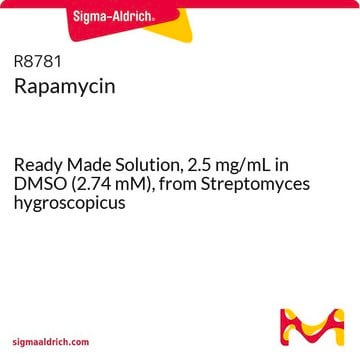475991
Torin1
≥99% (HPLC), powder, mTOR inhibitor, Calbiochem®
동의어(들):
mTOR Inhibitor XI, Torin1, 1-(4-(4-propionylpiperazin-1-yl)-3-(trifluoromethyl)phenyl)-9-(quinolin-3-yl)benzo[h][1,6]naphthyridin-2(1H)-one, DNA-PK Inhibitor VI, PI 3-K Inhibitor XVIII
About This Item
추천 제품
product name
mTOR Inhibitor XI, Torin1, mTOR Inhibitor XI, Torin1, CAS 1222998-36-8, is a cell-permeable, highly potent, ATP-competitive inhibitor of mTOR and DNA-PK (IC50 = 4.32 and 6.34 nM, respectively).
Quality Level
분석
≥99% (HPLC)
형태
powder
효능
2 nM IC50
제조업체/상표
Calbiochem®
저장 조건
OK to freeze
protect from light
색상
yellow-white
solubility
DMSO: 2 mg/mL
배송 상태
ambient
저장 온도
2-8°C
InChI
1S/C35H28F3N5O2/c1-2-32(44)42-15-13-41(14-16-42)31-11-9-26(19-28(31)35(36,37)38)43-33(45)12-8-24-20-40-30-10-7-22(18-27(30)34(24)43)25-17-23-5-3-4-6-29(23)39-21-25/h3-12,17-21H,2,13-16H2,1H3
InChI key
AKCRNFFTGXBONI-UHFFFAOYSA-N
일반 설명
생화학적/생리학적 작용
MTOR
포장
경고
재구성
기타 정보
Thoreen, C., et al. 2009. J Biol Chem.284, 8023.
법적 정보
Storage Class Code
11 - Combustible Solids
WGK
WGK 2
Flash Point (°F)
Not applicable
Flash Point (°C)
Not applicable
시험 성적서(COA)
제품의 로트/배치 번호를 입력하여 시험 성적서(COA)을 검색하십시오. 로트 및 배치 번호는 제품 라벨에 있는 ‘로트’ 또는 ‘배치’라는 용어 뒤에서 찾을 수 있습니다.
이미 열람한 고객
자사의 과학자팀은 생명 과학, 재료 과학, 화학 합성, 크로마토그래피, 분석 및 기타 많은 영역을 포함한 모든 과학 분야에 경험이 있습니다..
고객지원팀으로 연락바랍니다.












